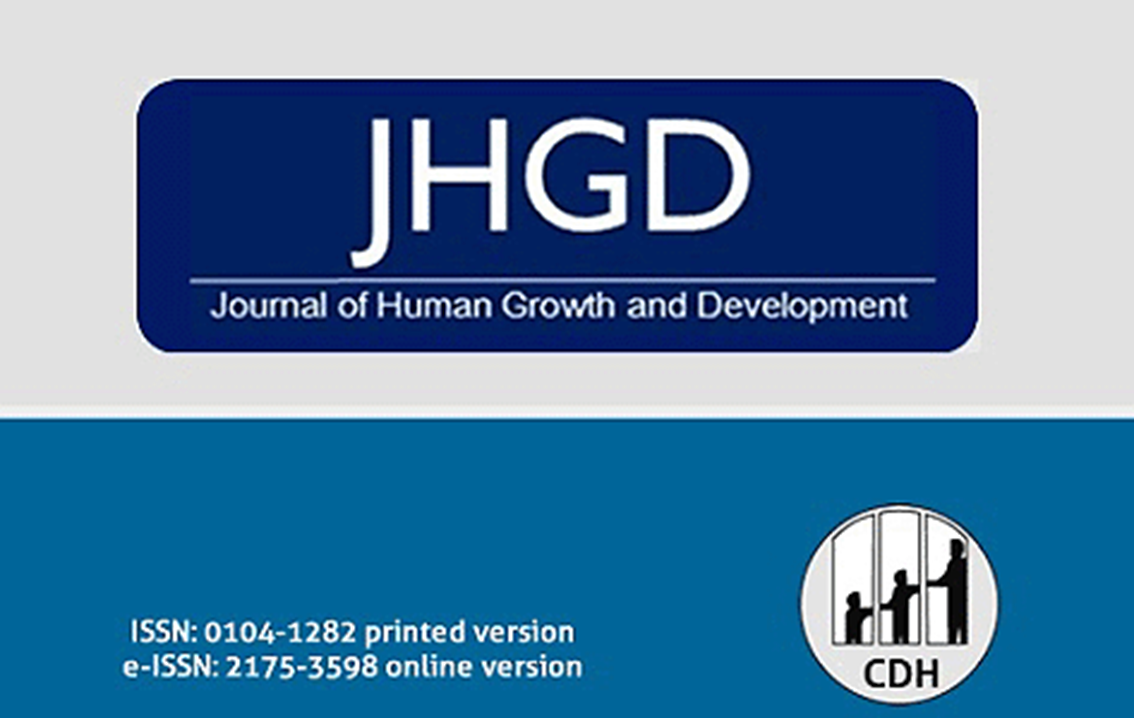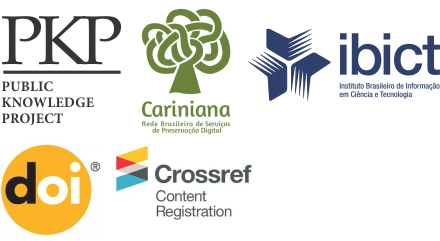Prevalence of obesity, high blood pressure, dyslipidemia and their associated factors in children and adolescents in a municipality in the Brazilian Amazon region
DOI:
https://doi.org/10.36311/jhgd.v31.11209Keywords:
Chronic Noncommunicable Disease, Brazilian Amazon, StudentsAbstract
The prevalence of CND are rocketting over the world, including in young adults. The WHO estimates that more than half of the deaths in the world are caused by CND.
The authors carried out a cross-sectional study of 1,431 school children in the Brazilian Western Amazon, with children and young people aged 6 to 16 years. A random sampling of 496 individuals was carried out. The OpenEpi platform was used to calculate the sample size, considering p<0.05 and a presumed prevalence of CND of 50%. The authors applyied a clinical-epidemiological questionnaire, made anthropometric measurements and laboratory tests. The authors used the diagnostic parameters recommended by the most recent guidelines of the Ministry of Health in Brazil
The study aimed to estimate the prevalence of obesity, high blood pressure (HBP) and dyslipidemia and its risk factors.
Prevalence of CND was: Obesity 11.8%, HBP of 6.7% and Dyslipidemia of 25.4%. After multivariate log-binomial analysis of the dependent variables, the statistically significant risk factors were: overweight 18.4%, sedentarism 32.2%, familial history of cardiovascular disease 23.4%, familial history of HBP 84.2%, familila dyslipidemia 55.8%, familial obesity 38.7% and familial chronic renal disease 40.6%.
The findings point to a picture with a relatively high prevalence of CNDs, as well as their risk factors. Intervention measures such as health education, food education, stimulation of physical exercise, and better school feeding are needed to mitigate the occurence of CND. It also points for the weakness of the local public health system, wehre specific health programmes already exist.
Downloads
References
Alwan A, MacLean DR, Riley LM, d’Espaignet ET, Mathers CD, Stevens GA, et al. Monitoring and surveillance of chronic non-communicable diseases: progress and capacity in high burden countries. The Lancet. novembro de 2010; 376(9755): 1861–8.
Vos T, Lim SS, Abbafati C, Abbas KM, Abbasi M, Abbasifard M, et al. Global burden of 369 diseases and injuries in 204 countries and territories, 1990–2019: a systematic analysis for the Global Burden of Disease Study 2019. The Lancet. outubro de 2020; 396(10258): 1204–22.
Pereira PB, Arruda IKG de, Cavalcanti AMT de S, Diniz A da S. Perfil lipídico em escolares de Recife - PE. Arq Bras Cardiol. outubro de 2010;95(5):606–13.
Hagströmer M, Oja P, Sjöström M. The International Physical Activity Questionnaire (Ipaq): a study of concurrent and construct validity. Public Health Nutr. setembro de 2006; 9(6): 755–62.
Shaw JE, Sicree RA, Zimmet PZ. Global estimates of the prevalence of diabetes for 2010 and 2030. Diabetes Research and Clinical Practice [internet]. 2010 Jan [cited 2020 oct 20]; 87(1): 4-14. Available from: https://doi.org/10.10/j.diabres.2009.10.007
Instituto Brasileiro de Geografia e Estatística. Tábua completa de mortalidade para o Brasil – 2013. Breve análise da mortalidade nos períodos 2012-2013 e 1980-2013. Rio de Janeiro, DF: IBGE; 2014. Em https://biblioteca.ibge.gov.br/vizualização/periodicos/3097/tcmb_pdf.2013 acessado em julho 2018.
Clinical & biomedical research [Internet]. [citado 26 de fevereiro de 2021]. Disponível em: https://seer. ufrgs.br/hcpa
Duncan BB, França EB, Passos VM de A, Cousin E, Ishitani LH, Malta DC, et al. The burden of diabetes and hyperglycemia in Brazil and its states: findings from the Global Burden of Disease Study 2015. Rev bras epidemiol. maio de 2017;20(suppl 1):90–101.
Instituto Brasileiro de Geografia e Estatística. Pesquisa nacional de saúde do escolar: 2015 / IBGE, Coordenação de População e Indicadores Sociais. – Rio de Janeiro: IBGE, 2016. 132 p. Em https: // biblioteca.ibge.gov.br/visualizacao/livros/liv97870.pdf acessado em julho 2018.
Kit BK, Kuklina E, Carroll MD, Ostchega Y, Freedman DS, Ogden CL. Prevalence of and trends in dyslipidemia and blood pressure among us children and adolescents, 1999-2012. JAMA Pediatr. 1o de março de 2015; 169(3): 272.
Borges CQ, Silva R de CR, Assis AMO, Pinto E de J, Fiaccone RL, Pinheiro SMC. Fatores associados à anemia em crianças e adolescentes de escolas públicas de Salvador, Bahia, Brasil. Cad Saúde Pública. abril de 2009; 25(4): 877–88.
Brant LCC, Nascimento BR, Passos VMA, Duncan BB, Bensenõr IJM, Malta DC, et al. Variações e diferenciais da mortalidade por doença cardiovascular no Brasil e em seus estados, em 1990 e 2015: estimativas do Estudo Carga Global de Doença. Rev bras epidemiol. maio de 2017; 20 (suppl 1): 116–28.
Rosner B, Cook NR, Daniels S, Falkner B. Childhood blood pressure trends and risk factors for high blood pressure: the nhanes experience 1988–2008. Hypertension. agosto de 2013; 62(2): 247–54.
Freedman DS, Goodman A, Contreras OA, DasMahapatra P, Srinivasan SR, Berenson GS. Secular trends in bmi and blood pressure among children and adolescents: the bogalusa heart study. PEDIATRICS. 1o de julho de 2012; 130(1): e159–66.
Bloch KV, Klein CH, Szklo M, Kuschnir MCC, Abreu G de A, Barufaldi LA, et al. ERICA: prevalences of hypertension and obesity in Brazilian adolescents. Rev Saúde Pública [Internet]. 2016 [citado 26 de fevereiro de 2021]; 50(suppl 1). Disponível em: http://www.scielo.br/scielo.php?script=sci_arttext&pid=S0034-89102016000200306&lng=en&tlng=en
Schroeder H. The new challenge: the aging process in the brazilian amazonia. J Gerontol Geriatr Res [Internet]. 2015 [citado 26 de fevereiro de 2021]; 04(01). Disponível em: http://www.omicsgroup. org/journals/the-new-challenge-the-aging-process-in-the-brazilian-amazonia-2167-7182-1000200. php?aid=41821
Vieira G de D, Basano S de A, Camargo LMA. Transition of the morbidity and mortality profile in a municipality in the interior of the Brazilian Amazon. Rev Soc Bras Med Trop. agosto de 2016; 49(4): 411–7.
Yoon JM. Dyslipidemia in children and adolescents: when and how to diagnose and treat? Pediatr Gastroenterol Hepatol Nutr. 2014; 17(2): 85.
Barros AJ, Hirakata VN. Alternatives for logistic regression in cross-sectional studies: an empirical comparison of models that directly estimate the prevalence ratio. BMC Med Res Methodol. dezembro de 2003; 3(1): 21.
Coutinho LMS, Scazufca M, Menezes PR. Methods for estimating prevalence ratios in cross-sectional studies. Rev Saude Publica. dezembro de 2008; 42(6): 992–8.
Moselakgomo VK, Toriola AL, Shaw BS, Goon DT, Akinyemi O. Índice de massa corpórea, sobrepeso e pressão arterial em escolares na província de limpopo, áfrica do sul. Rev paul pediatr. dezembro de 2012; 30(4): 562–9.
Patel ND, Newburn A, Brier ME, Chand DH. Pediatric hypertension: are pediatricians following guidelines? J Clin Hypertens. dezembro de 2016; 18(12): 1230–4.
Gerber ZRS, Zielinsky P. Fatores de risco de aterosclerose na infância. Um estudo epidemiológico. Arq Bras Cardiol. outubro de 1997; 69(4): 231–6.
Costanzi CB, Halpern R, Rech RR, Bergmann ML de A, Alli LR, Mattos AP de. Associated factors in high blood pressure among schoolchildren in a middle size city, southern Brazil. J Pediatr (Rio J). 7 de agosto de 2009; 85(4): 335–40.
Cardoso JL, Leone C. Growth achieved and correlation with blood pressure levels in schoolchildren. Rev Assoc Med Bras. outubro de 2018; 64(10): 896–901.
Schommer VA, Barbiero SM, Cesa CC, Oliveira R, Silva AD, Pellanda LC. Excess weight, anthropometric variables and blood pressure in schoolchildren aged 10 to 18 years. Arquivos Brasileiros de Cardiologia [Internet]. 2014 [citado 26 de fevereiro de 2021]; Disponível em: http://www.gnresearch.org/doi/10.5935/abc.20140038
Kumar S, Kelly AS. Review of childhood obesity. Mayo Clinic Proceedings. fevereiro de 2017; 92(2): 251–65.
Finn P. Dyslipidemia in overweight and obese school-aged children. NASN School Nurse. setembro de 2015; 30(5): 255–7.
Cote AT, Harris KC, Panagiotopoulos C, Sandor GGS, Devlin AM. Childhood obesity and cardiovascular dysfunction. Journal of the American College of Cardiology. outubro de 2013; 62(15): 1309–19.
Unger T, Borghi C, Charchar F, Khan NA, Poulter NR, Prabhakaran D, et al. 2020 International Society of Hypertension global hypertension practice guidelines. Journal of Hypertension. junho de 2020; 38(6): 982–1004.
Barbalho SM, Oshiiwa M, Sato Fontana LC, Ribeiro Finalli EF, Paiva Filho ME, Machado Spada AP. Metabolic syndrome and atherogenic indices in school children: A worrying panorama in Brazil. Diabetes & Metabolic Syndrome: Clinical Research & Reviews. novembro de 2017; 11: S397–401.
Sapunar J, Aguilar-Farías N, Navarro J, Araneda G, Chandía-Poblete D, Manríquez V, et al. Alta prevalencia de dislipidemias y riesgo aterogénico en una población infanto-juvenil. Rev méd Chile. dezembro de 2018; 146(10): 1112–22.
Vizentin NP, Cardoso PMS, Maia CAG, Alves IP, Aranha GL, Giannini DT. Dyslipidemia in adolescents seen in a university hospital in the city of rio de janeiro/brazil: prevalence and association. Arquivos Brasileiros de Cardiologia [Internet]. 2018 [citado 26 de fevereiro de 2021]; Disponível em: https://www.scielo.br/scielo.php?pid=S0066-782X2019000200147&script=sci_arttext
Gonçalves VS, Duarte EC, Dutra ES, Barufaldi LA, Carvalho KM. Characteristics of the school food environment associated with hypertension and obesity in Brazilian adolescents: a multilevel analysis of the Study of Cardiovascular Risks in Adolescents (Erica). Public Health Nutr. outubro de 2019; 22(14): 2625–34.
Pomerantz WJ, Timm NL, Gittelman MA. Injury patterns in obese versus nonobese children presenting to a pediatric emergency department. PEDIATRICS. 1o de abril de 2010; 125(4): 681–5.
Chan G, Chen CT. Musculoskeletal effects of obesity. Current Opinion in Pediatrics. fevereiro de 2009; 21(1): 65–70.
Yang J, Hu J, Zhu C. Obesity aggravates COVID-19: A systematic review and meta-analysis. J Med Virol. janeiro de 2021; 93(1): 257–61.
Hussain A, Mahawar K, Xia Z, Yang W, EL-Hasani S. RETRACTED: Obesity and mortality of COVID-19. Meta-analysis. Obesity Research & Clinical Practice. julho de 2020; 14(4): 295–300.
Kelly AS, Fox CK, Rudser KD, Gross AC, Ryder JR. Pediatric obesity pharmacotherapy: current state of the field, review of the literature and clinical trial considerations. Int J Obes. julho de 2016; 40(7): 1043–50.
Kelly AS, Barlow SE, Rao G, Inge TH, Hayman LL, Steinberger J, et al. Severe obesity in children and adolescents: identification, associated health risks, and treatment approaches: a scientific statement from the american heart association. Circulation. 8 de outubro de 2013; 128(15): 1689–712.
OPAS/OMS Brasil - Obesidade como fator de risco para morbidade e mortalidade: evidências sobre o manejo com medidas não medicamentosas [Internet]. [citado 26 de fevereiro de 2021]. Disponível em: https://www.paho.org/bra/index.php?option=com_docman&view=document&layout=default&alias=1535- obesidade-como-fator-risco-para-morbidade-e-mortalidade-evidencias-sobre-o-manejo-com medidasnao-medicamentosas-5&category_slug=serie-uso-racional-medicamentos 284&Itemid=965
Chee Cheong K, Yoon Ling C, Kuang Hock L, Mohd Ghazali S, Chien Huey T, Che Ibrahim M, et al. Association between availability of neighborhood fast food outlets and overweight among 5–18 year-old children in peninsular malaysia: a cross-sectional study. IJERPH. 18 de fevereiro de 2019; 16(4): 593.
Fock KM, Khoo J. Diet and exercise in management of obesity and overweight: Diet and exercise for weight management. J Gastroenterol Hepatol. dezembro de 2013; 28: 59–63
Downloads
Published
Issue
Section
License
Copyright (c) 2021 Juliana de Souza Almeida Aranha Camargo, Tallita Beatriz de Oliveira Zamarchi , Antônio Alcirley da Silva Balieiro , Felipe Arley Costa Pessoa , Luís Marcelo Aranha Camargo

This work is licensed under a Creative Commons Attribution 4.0 International License.







